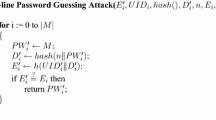Abstract
Two user authentication schemes for multi-server environments have been proposed by Tsai and Wang et al., respectively. However, there are some flaws existing in both schemes. Therefore, a new scheme for improving these drawbacks is proposed in this paper. The proposed scheme has the following benefits: (1) it complies with all the requirements for multi-server environments; (2) it can withstand all the well-known attacks at the present time; (3) it is equipped with a more secure key agreement procedure; and (4) it is quite efficient in terms of the cost of computation and transmission. In addition, the analysis and comparisons show that the proposed scheme outperforms the other related schemes in various aspects.



Similar content being viewed by others
References
Burrows M, Abadi M, Needham R (1990) A logic of authentication. ACM Trans Comput Syst 8(1):18–36
Chang CC, Kuo JY (2005) An efficient multi-server password authenticated key agreement scheme using smart cards with access control. In: 19th IEEE int conf advanced information networking and applications (AINA2005), Taipei, Taiwan, March 2005, vol 2, pp 257–260
Chien HY, Jan JK, Tseng YM (2002) An efficient and practical solution to remote authentication: smart card. Comput Secur 21(4):372–375
He D (2012) An efficient remote user authentication and key exchange protocol for mobile client-server environment from pairings. Ad Hoc Netw 10(6):1009–1016
He D, Chen J, Hu J (2012) An ID-based client authentication with key agreement protocol for mobile client-server environment on ECC with provable security. Inf Fusion 13(3):223–230
He D, Chen J, Hu J (2012) Improvement on a smart card based password authentication scheme. J Internet Technol 13(3):405–410
He D, Chen J, Zhang R (2012) A more secure authentication scheme for telecare medicine information systems. J Med Syst 36(3):1989–1995
Hsiang HC, Shih WK (2009) Improvement of the secure dynamic ID based remote user authentication scheme for multi-server environment. Comput Stand Interfaces 31(6):1118–1123
Hwang MS, Li LH (2000) A new remote user authentication scheme using smart cards. IEEE Trans Consum Electron 46(1):28–30
Hwang RJ, Shiau SH (2007) Provably efficient authenticated key agreement protocol for multi-servers. Comput J 50(5):602–615
Hwang MS, Lee CC, Tang YL (2002) A simple remote user authentication scheme. Math Comput Model 36(1):103–107
Juang WS (2004) Efficient multi-server password authenticated key agreement using smart cards. IEEE Trans Consum Electron 50(1):251–255
Kim S, Lim S, Won D (2002) Cryptanalysis of flexible remote password authentication scheme of ICN01. Electron Lett 38(24):1519–1520
Kim HS, Lee SW, Yoo KY (2003) ID-based password authentication scheme using smart cards and fingerprints. Oper Syst Rev 37(4):32–41
Ku WC (2005) Weaknesses and drawbacks of a password authentication scheme using neural networks for multiserver architecture. IEEE Trans Neural Netw 16(4):1002–1005
Ku WC, Chang ST, Chiang MH (2005) Weaknesses of a remote user authentication scheme using smart cards for multi-server architecture. IEICE Trans Commun E88-B(8):3451–3454
Ku WC, Chuang HM, Chiang MH (2005) Cryptanalysis of a multi-server password authenticated key agreement scheme using smart cards. IEICE Trans Fundam Electron Commun Comput Sci E88-A(11):3235–3238
Lamport L (1981) Password authentication with insecure communication. Commun ACM 24:77–772
Lee CC (2009) On security of an efficient nonce-based authentication scheme for SIP. Int J Netw Secur 9(3):201–203
Lee WB, Chang CC (2000) User identification and key distribution maintaining anonymity for distributed computer network. Comput Syst Sci Eng 15(4):211–214
Lee CC, Hwang MS, Yang WP (2002) A flexible remote user authentication scheme using smart cards. Oper Syst Rev 36(3):46–52
Lee JK, Ryu SR, Yoo KY (2002) Fingerprint-based remote user authentication scheme using smart cards. Electron Lett 38(12):554–555
Lee CC, Chung PS, Hwang MS (2013) A survey on attribute-based encryption schemes of access control in cloud environments. Int J Netw Secur 15(4):231–240
Li LH, Lin IC, Hwang MS (2001) A remote password authentication scheme for multi-server architecture using neural networks. IEEE Trans Neural Netw 12(6):1498–1504
Liao YP, Wang SS (2009) A secure dynamic ID based remote user authentication scheme for multi-server environment. Comput Stand Interfaces 31(1):24–29
Lin IC (2008) A neural network system for authenticating remote users in multi-server architecture. Int J Commun Syst 21:435–445
Lin CH, Lai YY (2004) A flexible biometrics remote user authentication scheme. Comput Stand Interfaces 27(1):19–23
Lin IC, Hwang MS, Li LH (2003) A new remote user authentication scheme for multi-server architecture. Future Gener Comput Syst 19:13–22
Liu Y, Gao W, Yao H, Yu X (2007) Elliptic curve cryptography based wireless authentication protocol. Int J Netw Secur 5(3):327–337
Sun HM (2000) An efficient remote user authentication scheme using smart cards. IEEE Trans Consum Electron 46(4):958–961
Tsai JL (2008) Efficient multi-server authentication scheme based on one-way hash function without verification table. Comput Secur 27:115–121
Tsai CS, Lee CC, Hwang MS (2006) Password authentication schemes: current status and key issues. Int J Netw Secur 3(2):101–115
Tsaur WJ (2001) A flexible user authentication scheme for multi-server Internet services. In: Networking-ICN. LNCS, vol 2093. Springer, Berlin, pp 174–183
Tsaur WJ, Wu CC, Lee WB (2004) A smart card-based remote scheme for password authentication in multi-server Internet services. Comput Stand Interfaces 27:39–51
Tsaur WJ, Wu CC, Lee WB (2005) An enhanced user authentication scheme for multi-server Internet services. Appl Math Comput 170:258–266
Tseng YM, Wu TY, Wu JD (2008) A pairing-based user authentication scheme for wireless clients with smart cards. Informatica 19(2):285–302
Wang S, Cao Z, Bao H (2008) Efficient certificateless authentication and key agreement (CL-AK) for grid computing. Int J Netw Secur 7(3):342–347
Wang RC, Juang WS, Lei CL (2009) User authentication scheme with privacy-preservation for multi-server environment. IEEE Commun Lett 13(2):157–159
Yang SP, Li X (2007) Defect in protocol analysis with BAN logic on man-in-the-middle attacks. Appl Res Comput 24(3):149–151
Acknowledgements
This research was partially supported by the National Science Council, Taiwan, R.O.C., under contract no.: NSC101-2221-E-030-018 and NSC101-2221-E-164-017.
Author information
Authors and Affiliations
Corresponding author
Rights and permissions
About this article
Cite this article
Chen, TY., Lee, CC., Hwang, MS. et al. Towards secure and efficient user authentication scheme using smart card for multi-server environments. J Supercomput 66, 1008–1032 (2013). https://doi.org/10.1007/s11227-013-0966-z
Published:
Issue Date:
DOI: https://doi.org/10.1007/s11227-013-0966-z




